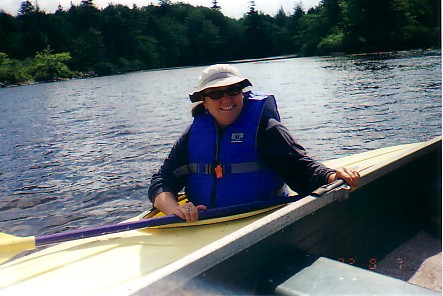Disclaimer & Copyright Notices; Optimized for the MS Internet Explorer

Biology 3624- Freshwater Systems, Summer 2002 at the Dalhousie University
Dalhousie Instructor: Tanya Holt MSc BEdGuest lecture by Shalom M. Mandaville B.E., Post-Grad Dip., Professional Lake Manage.
Soil & Water Conservation Society of Metro Halifax (SWCSMH)
The Cow Bay River watershed flow chart; and the Nova Scotia Lake Hypolimnion Project- Agriculture & Fisheries Dept., NS
Note: By clicking on some of the names in this web page, one can view the pictures of people (all photos were taken by Shalom M. Mandaville of the SWCSMH). No preference has been given to any one person; due to the practicality of keeping manageable web pages, only select anecdotes have been included
A "shallow lake" or "pond" is usually defined as a permanent standing body of water that is sufficiently shallow to allow light penetration to the bottom sediments adequate to potentially support photosynthesis of higher aquatic plants over the entire basin (Wetzel, 2001).
The LEI has also been cited/recommended in the latest handbook on Lake Management sponsored by the massive USEPA!
![[Img-biology3624-1.jpg]](BISSETT/PIC/biology3624-1.jpg)
![[Img-biology3624-8.jpg]](RUSSELL/PIC/biology3624-8.jpg)
![[Img-biology3624-2.jpg]](BISSETT/PIC/biology3624-2.jpg)
The following are from the Report of Bob Jordan and Rochelle Owen with the Corvallis Lab of USEPA's Lake Evaluation Index (LEI) values penned in by ink. Since only select scans are being included here, they will not be in sequence:
![[Img-PIC/jordan_owen1.jpg]](PIC/jordan_owen1.jpg)
![[Img-PIC/jordan_owen2.jpg]](PIC/jordan_owen2.jpg)
![[Img-PIC/jordan_owen3.jpg]](PIC/jordan_owen3.jpg)
![[Img-PIC/jordan_owen4.jpg]](PIC/jordan_owen4.jpg)
![[Img-PIC/jordan_owen5.jpg]](PIC/jordan_owen5.jpg)
![[Img-PIC/jordan_owen6.jpg]](PIC/jordan_owen6.jpg)
![[Img-PIC/jordan_owen7.jpg]](PIC/jordan_owen7.jpg)
![[Img-PIC/jordan_owen8.jpg]](PIC/jordan_owen8.jpg)
![[Img-PIC/jordan_owen9.jpg]](PIC/jordan_owen9.jpg)
![[Img-PIC/jordan_owen10.jpg]](PIC/jordan_owen10.jpg)
![[Img-PIC/jordan_owen11.jpg]](PIC/jordan_owen11.jpg)
![[Img-PIC/jordan_owen12.jpg]](PIC/jordan_owen12.jpg)
![[Img-PIC/jordan_owen14.jpg]](PIC/jordan_owen14.jpg)
![[Img-PIC/jordan_owen15.jpg]](PIC/jordan_owen15.jpg)
![[Img-PIC/jordan_owen16.jpg]](PIC/jordan_owen16.jpg)
![[Img-PIC/jordan_owen17.jpg]](PIC/jordan_owen17.jpg)
We salute the Chebucto Community Net (CCN) of Halifax, Nova Scotia, Canada for hosting our web site, and we applaud its volunteers for their devotion in making `CCN' the best community net in the world